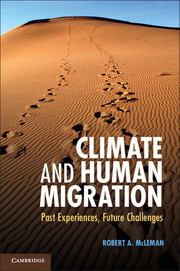Book contents
- Frontmatter
- Dedication
- Contents
- List of Figures
- List of Tables
- Preface
- Acknowledgments
- 1 An Introduction to the Study of Climate and Migration
- 2 Why People Migrate
- 3 Migration in the Context of Vulnerability and Adaptation to Climatic Variability and Change
- 4 Extreme Weather Events and Migration
- 5 River Valley Flooding and Migration
- 6 Drought and Its Influence on Migration
- 7 Mean Sea Level Rise and Its Implications for Migration and Migration Policy
- 8 Emergent Issues in Climate and Migration Research
- Annex Estimates of Global Population Exposed to Tropical Cyclones
- References
- Index
5 - River Valley Flooding and Migration
Published online by Cambridge University Press: 05 December 2013
- Frontmatter
- Dedication
- Contents
- List of Figures
- List of Tables
- Preface
- Acknowledgments
- 1 An Introduction to the Study of Climate and Migration
- 2 Why People Migrate
- 3 Migration in the Context of Vulnerability and Adaptation to Climatic Variability and Change
- 4 Extreme Weather Events and Migration
- 5 River Valley Flooding and Migration
- 6 Drought and Its Influence on Migration
- 7 Mean Sea Level Rise and Its Implications for Migration and Migration Policy
- 8 Emergent Issues in Climate and Migration Research
- Annex Estimates of Global Population Exposed to Tropical Cyclones
- References
- Index
Summary
Introduction
Of the various types of natural hazards to which human settlements are exposed, flooding affects the greatest number of people worldwide (Jonkman 2005). The Millennium Ecosystem Assessment suggests as many as 2 billion people worldwide may live in areas exposed to flooding risk (Millennium Ecosystem Assessment 2005). The vast majority of the world’s nations – an estimated 85 per cent – have experienced significant flood events in recent decades (Bakker 2009). Like droughts and extreme storms, floods are inherent, regularly occurring outcomes of climatic processes. In some regions, flooding is an annual risk because of high seasonal variability in precipitation. In others, floods occur irregularly. The size and scale of the human impacts of extreme floods can be tremendous. There are the immediate risks of death from drowning or injury from flowing debris, outbreaks of waterborne and insect-borne diseases generated by standing waters, and the longer-term mental health effects of experiencing such a crisis (Ohl 2000, Ahern et al. 2005). Housing, businesses, and critical infrastructure may be destroyed or damaged, creating enormous financial costs and requiring much time and effort to repair and replace. Yet, while floodplains are inherently hazardous, they also tend to make especially suitable locations for human settlements, providing easy access to fertile soils, potable water, hydraulic flow for irrigation and powering turbines, and the potential to transport goods and people by boat. Researchers estimate floodplains provide more than a quarter of all ecosystem services consumed by humans, despite representing a small fraction of the Earth’s surface (Tockner and Stanford 2002). It is therefore not surprising that human population numbers continue to rise in many of the world’s most flood-prone river valleys and deltas despite the risks.
- Type
- Chapter
- Information
- Climate and Human MigrationPast Experiences, Future Challenges, pp. 111 - 140Publisher: Cambridge University PressPrint publication year: 2013



